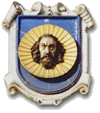Johannis bowl

As Johannis dish or as a locust shell designating iconography the presentation of a dish or bowl in which the severed head of St. John the Baptist is lying face up. The eyes, which are usually half-open, are intended to illustrate the divine vision of John, who died as a martyr .
Origin and meaning
The Johannessschüssel has its origin in the worship of relics in the High Middle Ages and found its way into the mystery play as well as the area of votive offerings in the late Middle Ages ; the sight of them was considered to be a help against head and neck diseases. The Johannesschüssel in Naumburg Cathedral from the early 13th century is considered the oldest surviving specimen .
heraldry
In heraldry , the bowl in silver or gold with the head is a common figure . A halo floats around the bearded head of the Baptist . Bowl and nimbus can overlap. There is a top view and a side view of this heraldic figure . The side view requires a base for the coat of arms.
Representations can also be found on many coins of the Order of St. John .
Examples
Wroclaw ( Breslau )
literature
- Hella Arndt, Renate Kroos: On the iconography of the Johannesschüssel. In: Aachener Kunstblätter . 38, 1969, ISSN 0515-0612 , pp. 243-328.
- Georg Geml: Early Johanness bowls . Diploma thesis at the historical and cultural studies faculty of the University of Vienna, 2009 ( online version (1) , online version (2) ).
- Gert Oswald : Lexicon of Heraldry. (From apple cross to twin bars). 2nd unchanged edition. Battenberg and Gietl, Regenstauf 2006, ISBN 3-86646-010-4 .
Web links
- Search for Johannisschüssel in the German Digital Library
- Search for Johannisschüssel in the SPK digital portal of the Prussian Cultural Heritage Foundation



